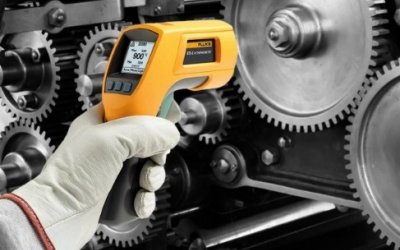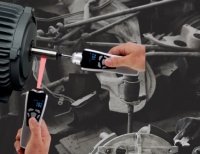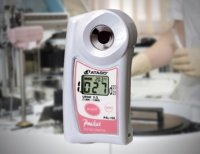How to Get the Best Results from your Digital Infrared Thermometer

When used correctly, digital infrared thermometers provide rapid and accurate surface temperature measurements. So you can always get the best results from your meter, our scientists have banded together and assembled a list of tips to ensure you make reliable measurements.
1. Be Aware of the Measurement Area
The first way to ensure you get the best results from your digital infrared thermometer is to confirm that you measure your targeted area. We understand this sounds like a fairly obvious point – but hear us out.
The area measured by your thermometer will change depending on your distance from the object measured. Further, each infrared thermometer will have a different distance to spot size measured.
So to ensure you measure the area of interest, you must know your thermometer’s distance to spot ratio. For example, if your distance-to-spot ratio of 12:1, your thermometer measures the temperature of a 1-inch diameter spot as if you are 12 inches from the surface (Figure 1).
Figure 1 Example of 12:1 distance to spot ratio on a digital infrared thermometer
|
IC TIP: Need to measure the temperature of a sample at close range? A low distance to spot ratio will suit your application. Want to measure a small area from a distance? Find an infrared thermometer with a higher distance to spot ratio. |
2. The Real Function of the Laser Pointer
A common issue digital infrared users encounter is being led astray by the laser. The laser is merely a guide, has nothing to do with taking a temperature measurement, and can’t always be trusted to indicate the centre of the measuring area.
You will find meters with no laser or a single, dual or multiple laser points – so be sure to check your user manual for your device’s specifics. Figure 2 (below) details examples of common laser pointer locations compared to the measuring area.
Figure 2 laser pointer locations and measurement area
3. Use Caution When Measuring Reflective Objects
Digital infrared thermometers are ideal for measuring everyday objects, but care must be taken when measuring shiny or reflective items. Because materials emit different amounts of infrared energy at the same temperature, reflective materials create a level of complication when measuring surface temperatures with a digital infrared thermometer.
To measure reflective objects, you will need to know the approximate emissivity of the object and have an infrared thermometer with adjustable emissivity functionality.
What is Emissivity?
Emissivity is the measure of how effectivity a surface can emit energy as infrared radiation. The emissivity scale is a value ranging from 0 to 1. Generally, the more reflective an object, the more the emissivity value will reduce.
Many items fall within the emissivity range of 0.95. As a result, most infrared thermometers will have a default emissivity setting of 0.95. If you need more detail, below is a table of items often measured for emissivity complied by Instrument Choice scientists. If your product’s surface is not listed below, contact an Instrument Choice Scientist for help.
|
Material |
Emissivity |
|
Polished aluminium |
0.05 |
|
Black electrical tape |
0.95 |
|
White paper |
0.90 |
|
Clear plastic |
0.94 |
|
Concrete |
0.95 |
|
Typical foods |
0.80-0.95 |
4. Temperature Fluctuations
The fourth recommendation to ensure you secure the best results from your infrared thermometer is to avoid “temperature shock” – that is, when there is a significant change in the ambient environment – like suddenly moving outdoors from a pleasant air-conditioned environment on a warm summer day. In the same way that it takes time for your body to adjust, you need to give your digital infrared thermometer time to acclimatise. Our team recommends that you allow 20 minutes for your thermometer to acclimatise before taking readings.
5. Lens and Ambient Conditions
A dirty or scratched lens will impair your meter’s ability to take temperature measurements. In the same way, dust particles, fog or steam, can affect accuracy by deflecting infrared energy before it reaches your thermometer.
The solutions are to protect your digital infrared thermometer’s lens from scratching by storing it in a case (when provided), and don’t take measurements in suboptimal conditions.
Conclusion
Follow the tips we’ve outlined above to ensure you use your digital infrared thermometer correctly to get consistent and dependable surface temperature measurements.
For more information or assistance with your thermometer, speak with an Instrument Choice Scientist! Call 1300 737 871 or email [email protected].
Further Reading: Digital Infrared Thermometers
- How do Infrared Thermometers work?
- 3 Common Misconceptions About Digital Infrared Thermometers
- IR Thermometers; How to read specifications
- What’s the difference between Medical and Industrial IR Thermometers?
- How to Setup the Fluke 62 Max IR Thermometer
- Product Review: The Fluke 568 Infrared Thermometer
- Product Review: HVAC PRO IR Thermometer (IC-FLUKE-561)
Also interesting
Digital tachometers are specially designed instruments for the measurement of rotational speed. Unfortunately, a vast array of digital tachometers available makes finding the best for your application can become challenging. For this reason, our scientists have created a list of five helpful tips that will help find the ideal digital tachometer for your application.
Get the exclusive list here

A refractometer is an instrument that measures the refractive index of a liquid. This article details what clinical refractometers are, what they measure and provides some product examples.
What is a clinical refractometer? Find out here

